Wearables-Assisted Smart Health Monitoring for Sleep Quality Prediction Using Optimal Deep Learning
Abstract
1. Introduction
- An intelligent WSHMSQP-ODL technique composed of pre-processing, DBN-based sleep quality prediction, and ESGO algorithm is presented. To the best of our knowledge, the WSHMSQP-ODL model has never presented in the literature;
- A novel ESGO algorithm is introduced by incorporating the concepts of opposition-based learning (OBL) with a traditional SGO algorithm;
- Hyperparameter optimization of the DBN model using ESGO algorithm using cross-validation helps to boost the predictive outcome of the WSHMSQP-ODL model for unseen data.
2. Related Works
3. The Proposed Model
3.1. Data Pre-Processing
3.2. Sleep Quality Prediction Using DBN
3.3. Parameter Adjustment Process
| Algorithm 1: Pseudocode of ESGO algorithm |
| Input: Seagull population Output: Optimal search agent Initialize parameters: and Consider Consider Consider while do define fitness value of seagulls for to (all the dimensions), do Fitness_Function end for choose optimum fitness value* for to do if then end if end for choose fitness values for search agent/ Perform OBL technique Choose and through greedy selection end while return |
4. Performance Validation
5. Conclusions
Author Contributions
Funding
Institutional Review Board Statement
Informed Consent Statement
Data Availability Statement
Conflicts of Interest
Ethics Approval
Consent to Participate
References
- Pardamean, B.; Budiarto, A.; Mahesworo, B.; Hidayat, A.A.; Sudigyo, D. Sleep Stage Classification for Medical Purposes: Machine Learning Evaluation for Imbalanced Data; Research Square: Durham, NC, USA, 2022. [Google Scholar]
- Phan, D.V.; Chan, C.L.; Nguyen, D.K. Applying Deep Learning for Prediction Sleep Quality from Wearable Data. In Proceedings of the 4th International Conference on Medical and Health Informatics; Association for Computing Machinery: New York, NY, USA, 2020; pp. 51–55. [Google Scholar]
- Sadeghi, R.; Banerjee, T.; Hughes, J.C.; Lawhorne, L.W. Sleep quality prediction in caregivers using physiological signals. Comput. Biol. Med. 2019, 110, 276–288. [Google Scholar] [CrossRef] [PubMed]
- Shen, Q.; Yang, X.; Zou, L.; Wei, K.; Wang, C.; Liu, G. Multi-Task Multi-Attention Residual Shrinkage Convolutional Neural Network for Sleep Apnea Detection Based on Wearable Bracelet Photoplethysmography. IEEE Internet Things J. 2022, 9, 25207–25222. [Google Scholar] [CrossRef]
- Ramachandran, A.; Karuppiah, A. A survey on recent advances in machine learning based sleep apnea detection systems. Healthcare 2021, 9, 914. [Google Scholar] [CrossRef] [PubMed]
- Palotti, J.; Mall, R.; Aupetit, M.; Rueschman, M.; Singh, M.; Sathyanarayana, A.; Taheri, S.; Fernandez-Luque, L. Benchmark on a large cohort for sleep-wake classification with machine learning techniques. NPJ Digit. Med. 2019, 2, 50. [Google Scholar] [CrossRef] [PubMed]
- Liang, Z.; Chapa-Martell, M.A. A multi-Level classification approach for sleep stage prediction with processed data derived from consumer wearable activity trackers. Front. Digit. Health 2021, 3, 665946. [Google Scholar] [CrossRef] [PubMed]
- Gashi, S.; Alecci, L.; Di Lascio, E.; Debus, M.E.; Gasparini, F.; Santini, S. The Role of Model Personalization for Sleep Stage and Sleep Quality Recognition Using Wearables. IEEE Pervasive Comput. 2022, 21, 69–77. [Google Scholar] [CrossRef]
- Sadeghi, R.; Banerjee, T.; Hughes, J. Predicting sleep quality in osteoporosis patients using electronic health records and heart rate variability. In Proceedings of the 2020 42nd Annual International Conference of the IEEE Engineering in Medicine & Biology Society (EMBC), Montreal, QC, Canada, 20–24 July 2020; pp. 5571–5574. [Google Scholar]
- Bahrami, M.; Forouzanfar, M. Deep Learning Forecasts the Occurrence of Sleep Apnea from Single-Lead ECG. Cardiovasc. Eng. Technol. 2022, 13, 809–815. [Google Scholar] [CrossRef] [PubMed]
- Arora, A.; Chakraborty, P.; Bhatia, M.P.S. Analysis of Data from Wearable Sensors for Sleep Quality Estimation and Prediction Using Deep Learning. Arab. J. Sci. Eng. 2020, 45, 10793–10812. [Google Scholar] [CrossRef]
- Zhang, Y.; Yang, Z.; Lan, K.; Liu, X.; Zhang, Z.; Li, P.; Cao, D.; Zheng, J.; Pan, J. Sleep stage classification using bidirectional lstm in wearable multi-sensor systems. In Proceedings of the IEEE INFOCOM 2019-IEEE Conference on Computer Communications Workshops (INFOCOM WKSHPS), Paris, France, 29 April–2 May 2019; pp. 443–448. [Google Scholar]
- John, A.; Cardiff, B.; John, D. A 1D-CNN based deep learning technique for sleep apnea detection in iot sensors. In Proceedings of the 2021 IEEE International Symposium on Circuits and Systems (ISCAS), Daegu, Korea, 22–28 May 2021; pp. 1–5. [Google Scholar]
- Hidayat, W.; Tambunan, T.D.; Budiawan, R. Empowering wearable sensor generated data to predict changes in individual’s sleep quality. In Proceedings of the 2018 6th International Conference on Information and Communication Technology (ICoICT), Bandung, Indonesia, 3–5 May 2018; pp. 447–452. [Google Scholar]
- Khoa, T.A.; Nguyen, D.V.; Nguyen Thi, P.V.; Zettsu, K. FedMCRNN: Federated Learning using Multiple Convolutional Recurrent Neural Networks for Sleep Quality Prediction. In Proceedings of the 3rd ACM Workshop on Intelligent Cross-Data Analysis and Retrieval; Association for Computing Machinery: New York, NY, USA, 2022; pp. 63–69. [Google Scholar]
- Arora, A.; Chakraborty, P.; Bhatia, M.P.S. Intervention of wearables and smartphones in real time monitoring of sleep and behavioral health: An assessment using adaptive neuro-fuzzy technique. Arab. J. Sci. Eng. 2022, 47, 1999–2024. [Google Scholar] [CrossRef]
- Cho, T.; Sunarya, U.; Yeo, M.; Hwang, B.; Koo, Y.S.; Park, C. Deep-ACTINet: End-to-end deep learning architecture for automatic sleep-wake detection using wrist actigraphy. Electronics 2019, 8, 1461. [Google Scholar] [CrossRef]
- Almanaseer, W.; Alshraideh, M.; Alkadi, O. A deep belief network classification approach for automatic diacritization of arabic text. Appl. Sci. 2021, 11, 5228. [Google Scholar] [CrossRef]
- Dhiman, G.; Kumar, V. Seagull optimization algorithm: Theory and its applications for large-scale industrial engineering problems. Knowl.-Based Syst. 2019, 165, 169–196. [Google Scholar] [CrossRef]
- Asiri, Y.; Halawani, H.T.; Alghamdi, H.M.; Abdalaha Hamza, S.H.; Abdel-Khalek, S.; Mansour, R.F. Enhanced Seagull Optimization with Natural Language Processing Based Hate Speech Detection and Classification. Appl. Sci. 2022, 12, 8000. [Google Scholar] [CrossRef]
- Sathyanarayana, A.; Joty, S.; Fernandez-Luque, L.; Ofli, F.; Srivastava, J.; Elmagarmid, A.; Arora, T.; Taheri, S. Sleep quality prediction from wearable data using deep learning. JMIR mHealth uHealth 2016, 4, e6562. [Google Scholar]
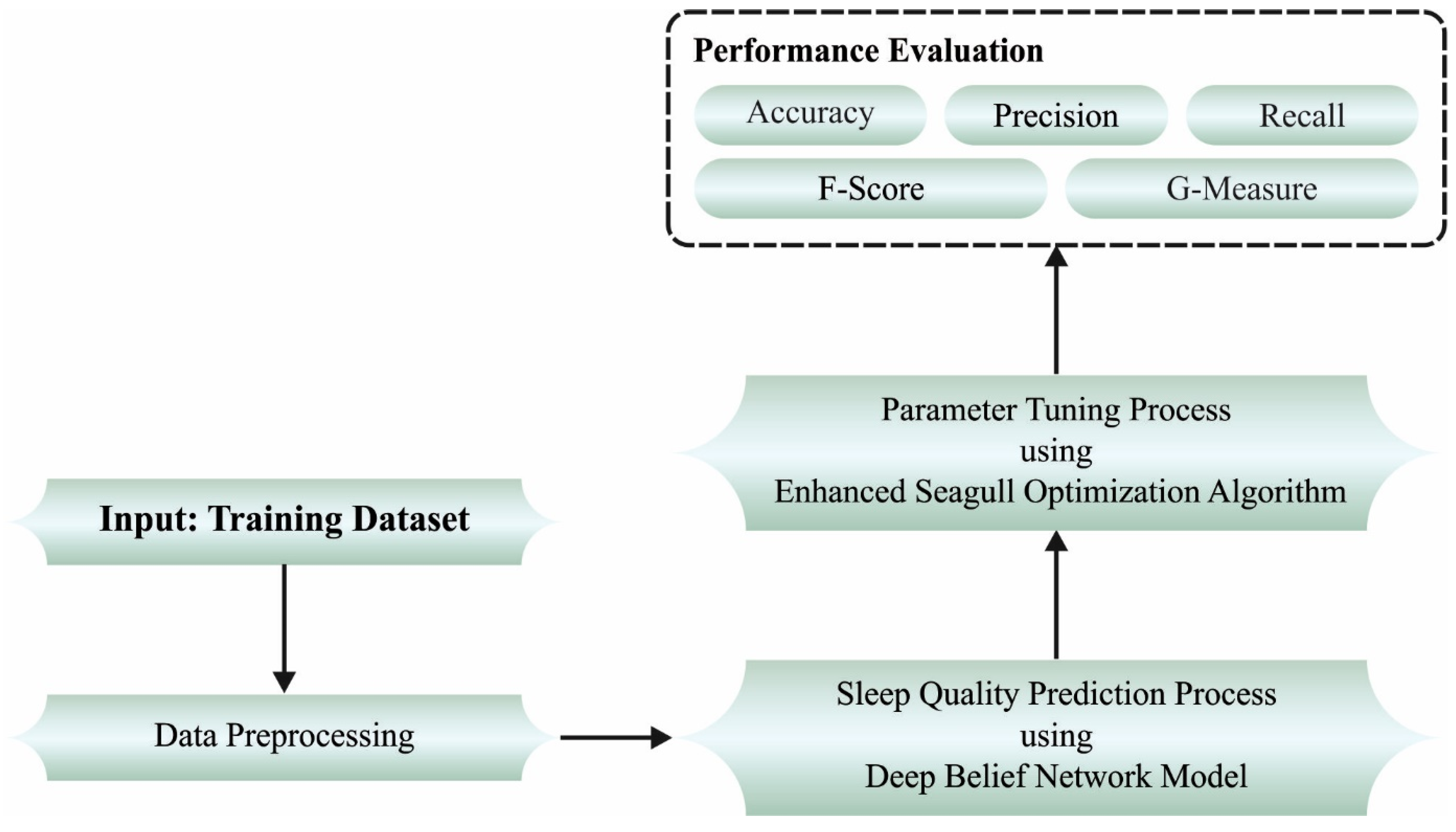
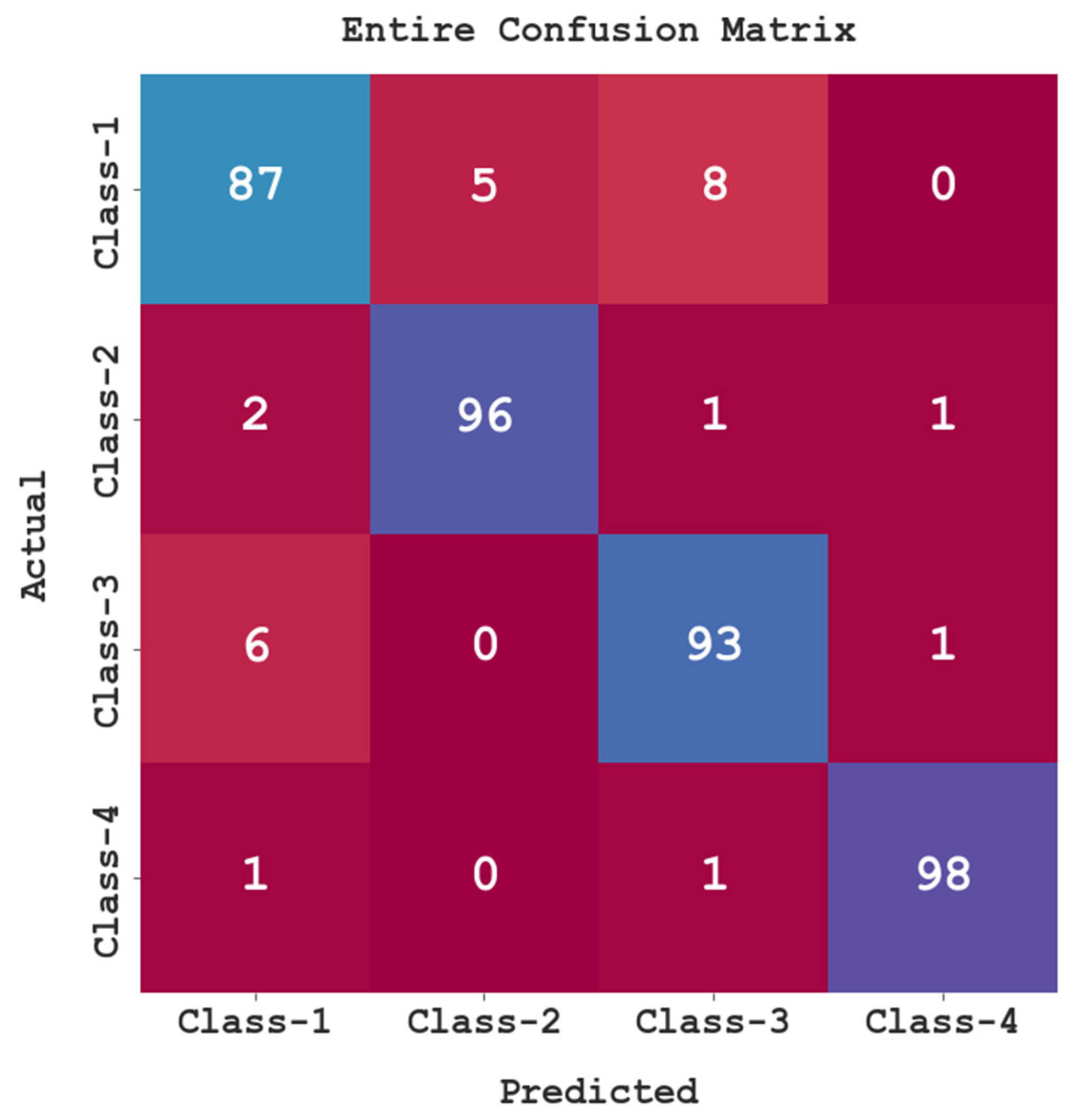
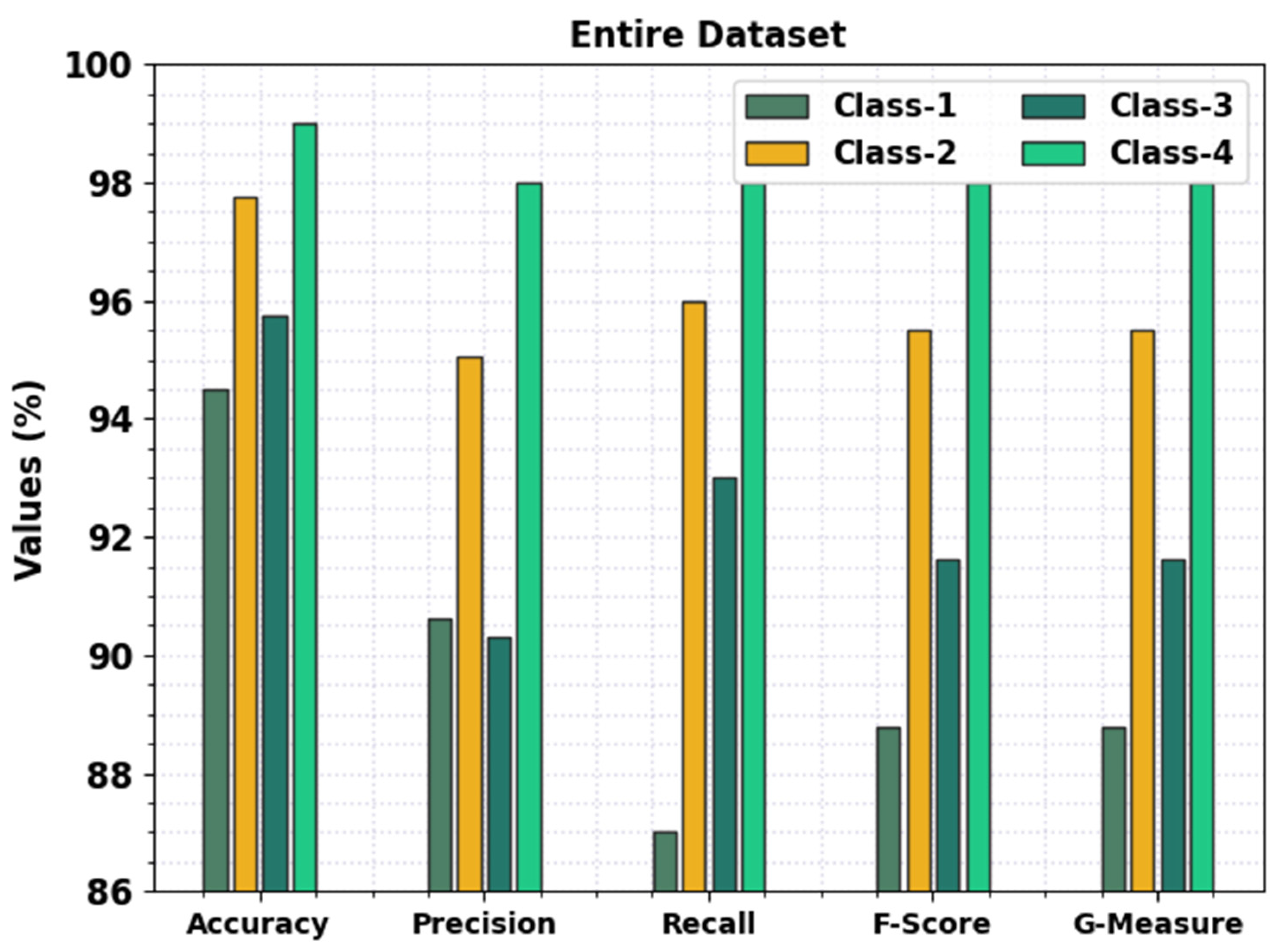
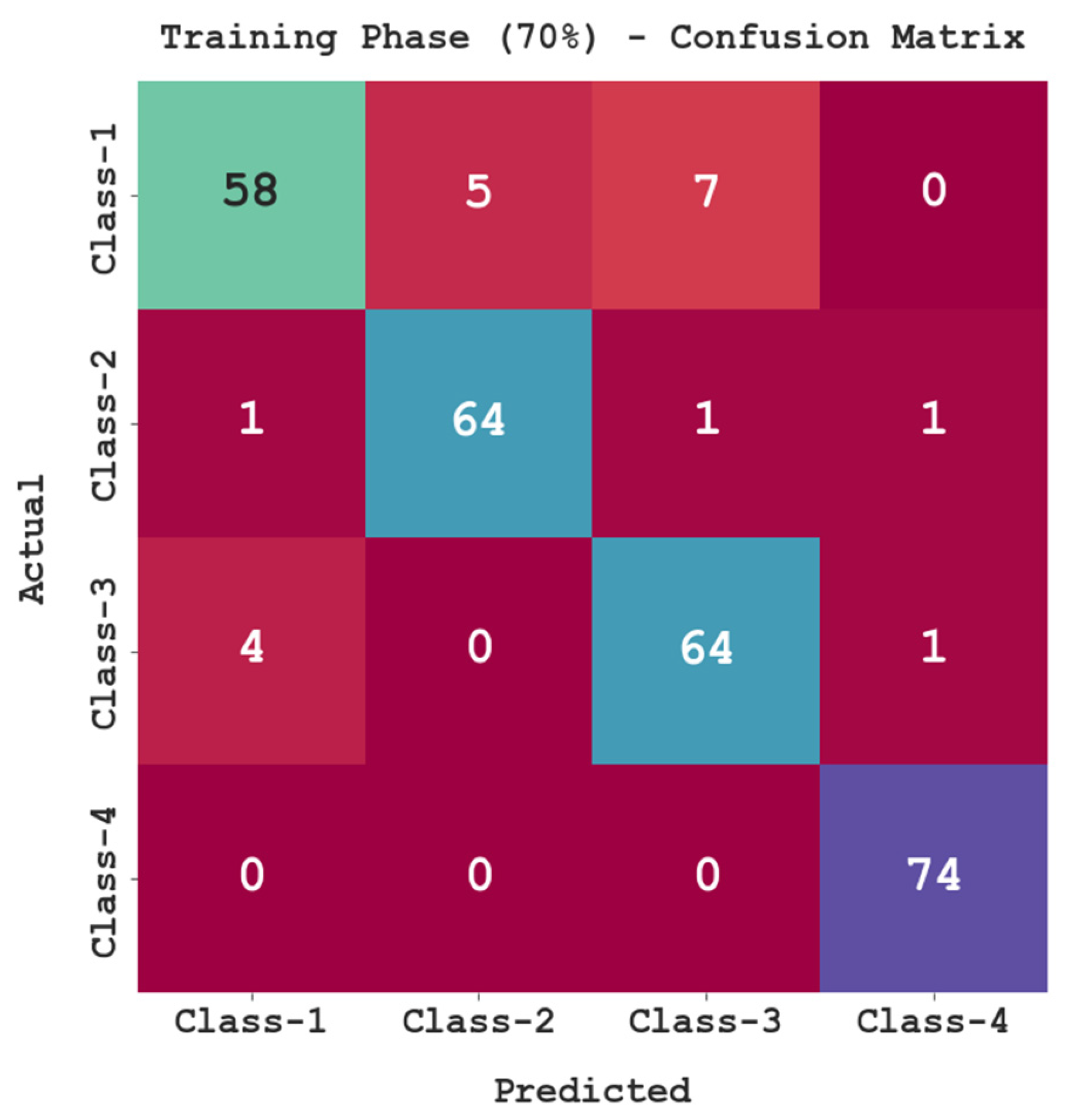
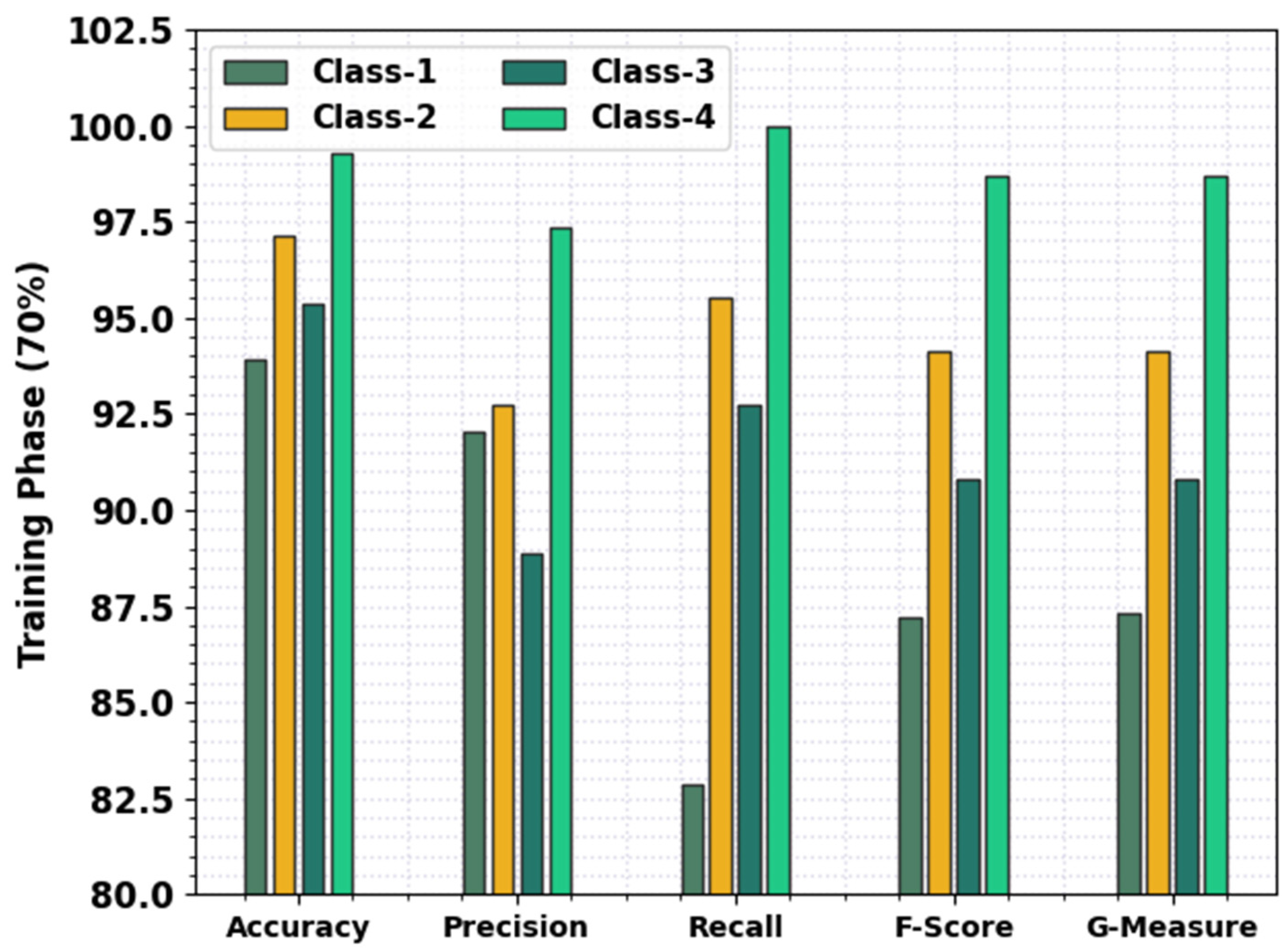
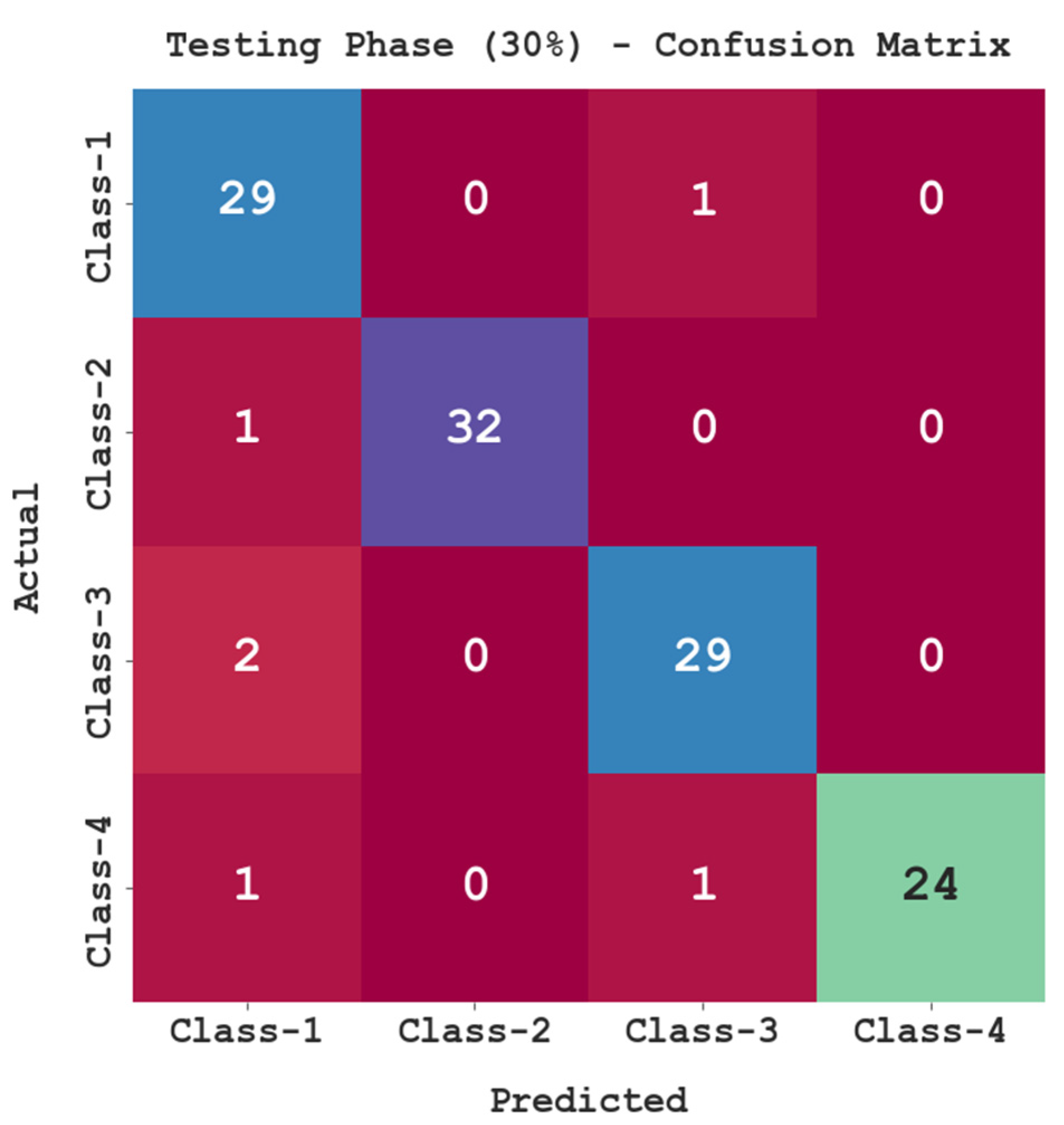

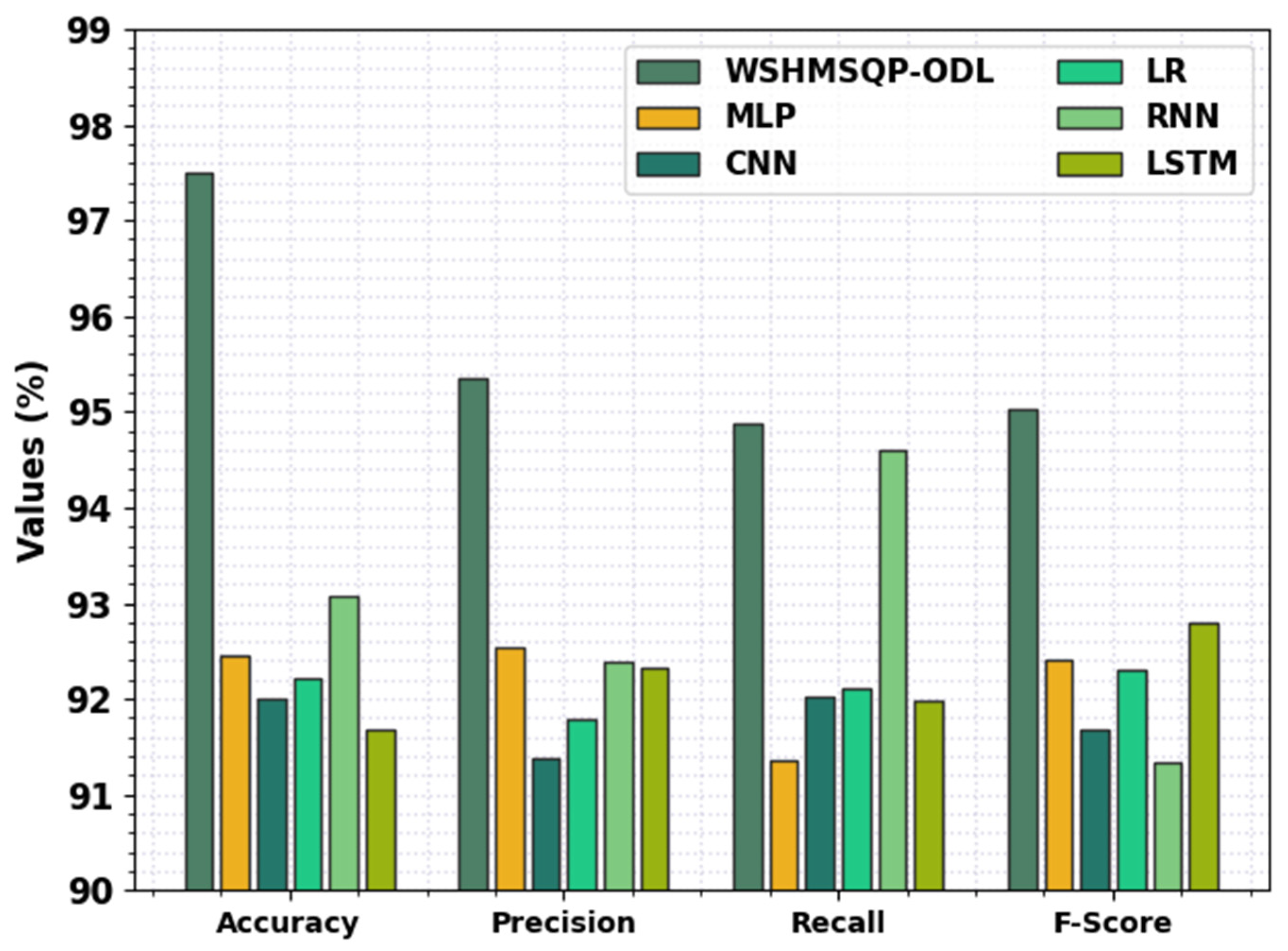
| Label | Class | Scale (%)-8 h | No. of Samples |
|---|---|---|---|
| Class 1 | Insufficient | 0–40 | 100 |
| Class 2 | Mild | 40–60 | 100 |
| Class 3 | Moderate | 60–80 | 100 |
| Class 4 | Sufficient | 80–100 | 100 |
| Total Number of Samples | 400 | ||
| Entire Dataset | |||||
|---|---|---|---|---|---|
| Labels | Accuracy | Precision | Recall | F-Score | G-Measure |
| Class 1 | 94.50 | 90.62 | 87.00 | 88.78 | 88.79 |
| Class 2 | 97.75 | 95.05 | 96.00 | 95.52 | 95.52 |
| Class 3 | 95.75 | 90.29 | 93.00 | 91.63 | 91.64 |
| Class 4 | 99.00 | 98.00 | 98.00 | 98.00 | 98.00 |
| Average | 96.75 | 93.49 | 93.50 | 93.48 | 93.49 |
| Training Phase (70%) | |||||
|---|---|---|---|---|---|
| Labels | Accuracy | Precision | Recall | F-Score | G-Measure |
| Class 1 | 93.93 | 92.06 | 82.86 | 87.22 | 87.34 |
| Class 2 | 97.14 | 92.75 | 95.52 | 94.12 | 94.13 |
| Class 3 | 95.36 | 88.89 | 92.75 | 90.78 | 90.80 |
| Class 4 | 99.29 | 97.37 | 100.00 | 98.67 | 98.68 |
| Average | 96.43 | 92.77 | 92.78 | 92.70 | 92.74 |
| Testing Phase (30%) | |||||
|---|---|---|---|---|---|
| Labels | Accuracy | Precision | Recall | F-Score | G-Measure |
| Class 1 | 95.83 | 87.88 | 96.67 | 92.06 | 92.17 |
| Class 2 | 99.17 | 100.00 | 96.97 | 98.46 | 98.47 |
| Class 3 | 96.67 | 93.55 | 93.55 | 93.55 | 93.55 |
| Class 4 | 98.33 | 100.00 | 92.31 | 96.00 | 96.08 |
| Average | 97.50 | 95.36 | 94.87 | 95.02 | 95.07 |
Disclaimer/Publisher’s Note: The statements, opinions and data contained in all publications are solely those of the individual author(s) and contributor(s) and not of MDPI and/or the editor(s). MDPI and/or the editor(s) disclaim responsibility for any injury to people or property resulting from any ideas, methods, instructions or products referred to in the content. |
© 2023 by the authors. Licensee MDPI, Basel, Switzerland. This article is an open access article distributed under the terms and conditions of the Creative Commons Attribution (CC BY) license (https://creativecommons.org/licenses/by/4.0/).
Share and Cite
Hamza, M.A.; Abdalla Hashim, A.H.; Alsolai, H.; Gaddah, A.; Othman, M.; Yaseen, I.; Rizwanullah, M.; Zamani, A.S. Wearables-Assisted Smart Health Monitoring for Sleep Quality Prediction Using Optimal Deep Learning. Sustainability 2023, 15, 1084. https://doi.org/10.3390/su15021084
Hamza MA, Abdalla Hashim AH, Alsolai H, Gaddah A, Othman M, Yaseen I, Rizwanullah M, Zamani AS. Wearables-Assisted Smart Health Monitoring for Sleep Quality Prediction Using Optimal Deep Learning. Sustainability. 2023; 15(2):1084. https://doi.org/10.3390/su15021084
Chicago/Turabian StyleHamza, Manar Ahmed, Aisha Hassan Abdalla Hashim, Hadeel Alsolai, Abdulbaset Gaddah, Mahmoud Othman, Ishfaq Yaseen, Mohammed Rizwanullah, and Abu Sarwar Zamani. 2023. "Wearables-Assisted Smart Health Monitoring for Sleep Quality Prediction Using Optimal Deep Learning" Sustainability 15, no. 2: 1084. https://doi.org/10.3390/su15021084
APA StyleHamza, M. A., Abdalla Hashim, A. H., Alsolai, H., Gaddah, A., Othman, M., Yaseen, I., Rizwanullah, M., & Zamani, A. S. (2023). Wearables-Assisted Smart Health Monitoring for Sleep Quality Prediction Using Optimal Deep Learning. Sustainability, 15(2), 1084. https://doi.org/10.3390/su15021084







